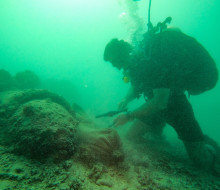
Second World War-era bombs in Vanuatu made safe by Navy divers
26 June 2024
Unfortunately you are viewing this website on an outdated browser which does not support the necessary features for us to provide an adequate experience. Please switch to a modern browser such as latest version of Google Chrome, Mozilla Firefox, Apple Safari or Microsoft Edge.
Ngā mihi nui
Royal New Zealand Navy (RNZN) Band member Petty Officer Fraser Robertson has returned to Gallipoli to play his part at Anzac Day commemorations for a third time.
A tuba player from Te Awamutu, Petty Officer Roberston played at the commemorations in Türkiye in 2014 and 2017 and was chosen again for this year’s event.
During the pre-deployment briefing, New Zealand Defence Force (NZDF) contingent historian Dr Andrew Macdonald noted there were plenty of serving brass-band musicians who landed at Gallipoli in 1915.
Sometimes they were members of regimental bands, but other times they were serving as soldiers in the front lines according to Dr Macdonald, a specialist military historian who holds an honorary captaincy with the RNZN.
“That kind of resonated for me after being to Gallipoli twice,” Petty Officer Robertson said.
While he was aware musicians had waded ashore at Anzac Cove he said he hadn’t know that some instruments had also been carried onto the peninsula.
Other research by author and editor Chris Bourke showed that while band music was almost absent from the historical record of Gallipoli, it was nonetheless heard by New Zealand troops serving there.
His research showed enough bandsmen landed on Gallipoli to form four bands.
In particular, Petty Officer Robertson was interested in the life of Private William Griffiths, who also played the tuba.
Private Griffiths was a stretcher bearer in the Auckland Battalion. During the August offensive to open the approach to Chunuk Bair, he suffered a gunshot wound to the head and later died at a hospital in Egypt.
Private Griffiths was born and raised in Timaru, but was based in Auckland at the time of his enlistment into the New Zealand Expeditionary Force. For many years this young man – known to family and friends as Sandy – was a bandsman in the Auckland City Corps of the Salvation Army.
“It’s quite intriguing,” Petty Officer Robertson said.
“Brass bands have played a significant part in my family and life. I am a third-generation member of the Te Awamutu Brass Band, and my family is still heavily involved with the local band.”
Most of the 40-strong NZDF contingent arrived in Türkiye about a week before the 25 April anniversary to acclimatise and rehearse before the ceremonies.
Battlefield tours were part of the programme so the members could learn more about their predecessors and the battles that were fiercely fought at Gallipoli, and where, in some places, both sides’ trenches were as little as five metres apart.
“The landscape still amazes me. You see how far away the Turkish soldiers would have been from the New Zealanders to the point where they could have easily had a conversation,” Petty Officer Roberston said.
As well as conversations, Turkish soldiers would have heard music being played by the New Zealand troops – an aspect of the campaign which is not well known.
According to New Zealand music website Audioculture, while musicians and music were not common during the campaign, they did feature.
Small musical gatherings were sometimes held relatively close to the Turkish lines.
For safety reasons, the Canterbury Battalion’s musicians played their first concert in the dark in Canterbury Gully - also known as Rest Gully. The following evening, the Turks brought their own band to the trenches. Both events were eventually drowned out by rifle and artillery fire.
The commander of the Wellington Battalion, Lieutenant-Colonel William Malone, also documented that musical gatherings took place. He wrote that the musicians – whom he thought would not perform well in war – had proved their bravery as stretcher bearers.
During the NZDF contingent’s recent battlefield tour, Dr Macdonald outlined the importance of song at Gallipoli, explaining how veterans he had interviewed talked about occasional sing-alongs among small groups of soldiers when away from the front line at places such as Rest Gully, the Maori Pah and Plugge's Plateau, among others.
“Based on what these elderly men – men who had served at these places inside the Anzac perimeter – told me, song was a form of distraction from what they had been through, as well as a form of camaraderie. It was also a means of relaxation.”